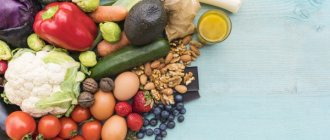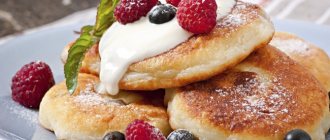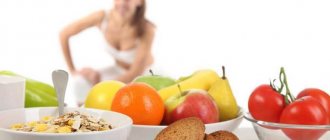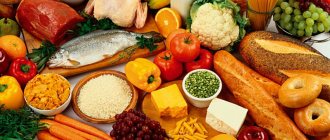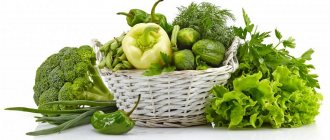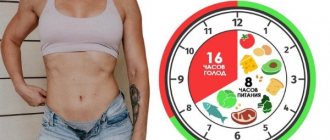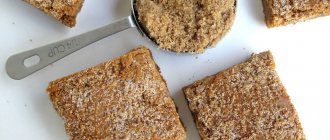Diet plan
A sugar-free diet involves avoiding only foods containing sugar.
It can be used not only for weight loss, but also for health improvement. There is no need to create a calorie deficit. It is recommended to prepare before starting the diet. To do this, over the course of 2-3 weeks, you should gradually reduce the amount of sweets and other foods containing harmful substances in your diet.
A savory diet also requires proper completion. When the 3 weeks are over, you cannot immediately include a large number of sweets on the menu. Eating desserts is allowed, but it is better not to introduce a lot of them at once, and control your sugar intake.
Sugar in sauces and seasonings
A typical savory food you wouldn't expect to be loaded with sugar, but jars of pasta sauce can be full of sugar, and some companies even advise consuming their products once a week.
The same goes for ketchups, barbecue sauces, salad dressings and various other condiments.
Products without refined sugar
Refining is the removal of foreign impurities, usually during a certain processing process. Such products are less healthy and are not fully absorbed, because the human digestive system is designed for unrefined natural food.
It happens that in the process of cleansing one gets rid of not only the unnecessary, but also the useful. During refining, for example, the components inherent in the raw material are removed from sugar, such as malt, which contains pectins.
Refined sugar dissolves more easily and looks more attractive than yellow sugar with a high level of malt, which dissolves less well and forms foam. But unattractive sand brings more health benefits. In addition, the technology for processing and bleaching sugar beets or cane involves the use of various chemicals and filters that leave their “traces” in the snow-white sand.
Refined carbohydrates are the main substances for energy nutrition of the body. But most of them are deposited in fat reserves, which provokes obesity, metabolic disorders, and diabetes. Refined sugars cause a lot of harm:
- provoke excess weight;
- stimulate false hunger, which is fraught with overeating and the same consequences;
- promote skin aging;
- cause addiction;
- lead to vitamin B deficiency;
- deplete energy depot;
- weaken the heart muscle;
- wash away calcium;
- reduce the level of immunity.
Refined products can be easily replaced with healthy analogues, for example:
- premium flour - oatmeal, corn, buckwheat, rice, pea, lentil, whole grain flour;
- sugar – honey, stevia, maple syrup, dried fruits;
- vegetable oil - olive, melted butter;
- polished rice - unrefined rice grains.
The main danger is that refined sugar is found in almost all packaged foods and drinks, fast food, and white flour products. It is much healthier to choose sugar-free foods.
Unfortunately, yellow unrefined sugar is much more expensive, and there is little choice in stores, and there is a risk of counterfeiting and adulteration. Sparsely and with a choice of products without refined sugar. To eliminate the sweet component from your diet, you need to eat at home and only freshly prepared food.
The importance of natural sugars
During a hypoglycemic diet, the body still requires carbohydrates. One source is foods containing fructose. Healthy carbohydrates support the level of physical activity, the process of repairing damaged tissues, and provide energy to the tissues of the body and brain. The whole difference is that we will consume only the required amount. Here are some of the facts you should consider when shaping your diet:
- Dietary fiber contained in fruits and vegetables is not fully absorbed by the body, so you should not take into account their specific gravity as a carbohydrate component of nutrition. They are useful in themselves, but are not any significant source of energy;
- Fiber is essential for maintaining healthy digestive and cardiovascular function. In addition, it allows you to control the feeling of satiety.
- Dietary fiber and fiber are often found in low-calorie foods that are high in vitamins, minerals and antioxidants. These include: leafy vegetables, berries, apples, beans, seeds, avocados and sweet potatoes. Some of these foods contain fructose, which shouldn't alarm you given the treasure trove of nutrients they contain.
- Don't forget to replenish your micronutrient reserves. Pay attention to potassium, magnesium, antioxidants: carotenoids, beta-carotene, lycopene, vitamins E and C.
List of delicious sugar-free foods
Low Carb Vegetables
- Zucchini – 7g in one medium-sized fruit. This vegetable will be an excellent replacement for pasta and potatoes in side dishes for meat dishes. The product is famous for its large amount of useful substances: potassium, magnesium, vitamins B6 and C.
- Cauliflower – 5 g per cup. By the way, this vegetable contains a decent supply of antioxidants.
- Swiss chard – 1 g per cup. Can be fried or used raw for salads.
- Champignons – 2 g per cup. Good not only for weight control, but also for strengthening the immune system.
- Celery – 1 g in 1 stalk. An excellent source of vitamin K, which is necessary for the absorption of calcium. It requires more energy to digest than it provides.
Other low-carb vegetables: cherry tomatoes, bell peppers, arugula, spinach, asparagus, Chinese cabbage.
Fruits with low carbohydrates
- Apricots – 8 g in two fruits.
- Avocado – 16 g in one piece.
- Strawberries – 11 g per cup.
Other low-carb fruits: watermelon, peaches, rhubarb, blueberries.
Meat and fish
The following products contain 0 g of carbohydrates per 100 g:
Chicken drumstick, pork tenderloin, steak, roast beef, elk, chicken, ground beef, turkey breast. These foods can be the basis of your diet if you want to lose weight or build muscle.
Healthy snacks
Not very high in carbohydrates in jerky (3g per 30g), walnuts (8g per 30g), hazelnuts, pecans, sunflowers. If you want to snack on something sweet, Racionika protein muesli bars in banana, coconut, pineapple, blueberry and other popular flavors are a good choice. Contains natural fruits and nuts, sweeteners, milk and soy protein. You can choose a bar with the required energy value: 196 kcal, 177 kcal, 129 kcal, 143/133 kcal.
Diet rules for weight loss based on products without added sugar
The idea of no-carb diets is very simple. The body primarily draws energy from them, and converts the excess into fat and stores it in reserve. If there are fewer carbohydrates, the body has to somehow make up for the lack of energy, which means burning fat deposits.
In order for such nutrition to be effective and not harmful to health, you should remember some nuances.
- Maintain a balance of proteins, fats and carbohydrates in your diet. This will allow you not only to gradually achieve the desired result, but also not to damage your body. The standard ratio of BJU for people who want to lose weight: 40-50% proteins, 30-40% fats, 10-20% carbohydrates.
- You should stick to a strict protein diet with low carbohydrate content for no longer than a month. Remember that such a diet puts a lot of strain on the liver and kidneys and can lead to intoxication. High-protein diets are effective, but you need to approach them wisely.
- Avoidance of foods without gluten, fructose and other carbohydrates is contraindicated for people with diseases of the digestive system and kidneys.
- The body absorbs up to 30 grams of protein in one meal, so eating more high-protein foods does not make sense. The best way out is to eat more often (5-6 times a day), but in small portions.
- Do not reduce the amount of calories sharply - by more than 400 kcal per day. This will cause the body to store nutrients.
Precautionary measures
Depending on how many carbohydrates you continue to consume, you may experience some side effects after quitting sugar. They usually go away within one to three weeks as your body adjusts to the diet. A smoother transition to a new diet may be required depending on the intensity of adverse events. The most common symptoms are:
- feeling lethargic and tired;
- digestive problems such as bloating and gas;
- decreased intelligence;
- changes in appetite and sleep;
These processes are associated not so much with diet as with sugar withdrawal syndrome. The sensations are quite interesting, you feel like a former drug addict...
We recommend that you take a closer look at this pleasant and tasty sugar substitute -!
What about sugar substitutes?
Sugar substitutes are also sweeteners.
So-called sugar alcohols are used in metabolism independently of insulin. Therefore, they were previously used in diabetic products.
Their energy content is 2.4 kilocalories per gram. This is significantly less calories than sugar. Erythritol contains no calories. Because they do not promote tooth decay, they are often found in “sugar-free” candies and “tooth-friendly” candies.
They are also increasingly used in the production of sugary drinks and finished products. Large amounts of sugar alcohols can have a laxative effect, which can cause diarrhea.
Eight sweeteners are allowed in the EU
Sorbitol (E 420) Mannitol (E 421) Isomalt (E 953) Polyglycytol syrup (E 964) Maltitol/ol (E 965) Lactitol (E 966) Xylitol (E967) Erythritol (E 968)
Sweetening power: Only xylitol has the same sweetening power as sugar, the others are about twice as sweet. Advantages: Unlike sweeteners, sweeteners have the same consistency as sugar and can therefore also be used in chocolate or sweets. Their metabolism does not require insulin, which is beneficial for diabetics. Disadvantages: Consuming more than 20g (about half a diet chocolate bar) may cause bloating and diarrhea.3
Instructions on how to find and replace hidden sugars
We buy a lot of products where insidious sugar is hidden. This list will help you identify the “pests” that have taken up residence in your refrigerator.
Eliminate sauces
Many children like to dip food in sauce: without this, it is not as tasty and interesting for them, and besides, this can “sweeten the pill” if there are boring vegetables or proteins on the plate. The sauces that many children love - honey, sweet and sour, barbecue, ketchup - are often full of sugar. Typically, for every tablespoon of ketchup there is one teaspoon of sugar (4 g). Ketchups and sauces that contain a lot of sugar can be replaced with sour cream, homemade ketchup, yogurt and nut butter. Tabasco and salsa without sugar are also useful.
Be aware of how much sugar is in the product
Look at what is written about sugars on the label of the products you buy, especially those that children really ask for. It is very likely that you will find added sugar in them. Remember that 4 g of sugar is one teaspoon, and this is a lot for products that should not have sugar at all: crackers, canned vegetables, sauces. Children can eat as little as three to eight teaspoons (12–32 g) of extra sugars per day, depending on age.
We recommend: Eating beets for diabetes mellitus; whether or not you can include the vegetable in the diet for types 1 and 2 of the disease
Look at the ingredients and don't buy brands that have sugar among the first three ingredients (or the first four if the first three include water). Don't forget that sugar can be called by different names.
Don't buy low-fat foods
Low-fat foods tend to have more sugar than regular varieties. To compensate for the taste, sugar is often added to low-fat and nonfat foods. Look at the ingredients list, but generally speaking, it's better to buy your child foods that contain normal fat, but in smaller quantities, rather than low-fat varieties with extra sugar.
Yogurts are not always healthy
Because of the extra sugar, in most cases yoghurts are not as great a food as they might seem. There are eight teaspoons of sugar in 225g of low-fat, fruity yoghurt!
Canned fruits and vegetables also contain sugar
Choose canned vegetables without added sugar. We found excess sugar in the following foods: canned corn, white sauce corn, peas, squash, collard greens. Bottled, canned, and individually packaged fruit usually contains some form of added sugar: syrup, fruit juice, and so on. It is better not to buy fruits with any kind of syrup. Look for canned foods without sugar or with water, and if not available, opt for foods sweetened with fruit juice.
Be careful with grains
Many grain products, such as cookies, cakes and pies, are loaded with sugar. Moreover, these are not only standard sweets, but also bread, buns, breadcrumbs, crackers, cereal bars, muesli, candy bars and ready-made breakfasts.
Read labels correctly
The ingredient list tells you more about the product than anything else on the package. The first ingredient listed gives the largest weight percentage, and the last one gives the smallest. If sugar in one of its many forms is among the first three ingredients, look for something better. Water is not considered an ingredient, so if sugar is in fourth place, but water comes before it, do not take this product.
- What else does the product label tell you?
Buy products in natural form
If a child eats 37 grams (1/4 cup) of strawberries, they will receive 1.8 grams of sugar. And if you buy him a 100% fruit bar weighing the same 37 g, the sugar will already be as much as 29 g. Just because the packaging says “100% fruit” does not mean that it contains less sugar than a chocolate bar.
Choose tomato-based products carefully
Tomato-based products are an important source of hidden sugar. It is impossible to determine how much sugar was added and how much is contained in the tomatoes themselves. To give you some perspective, if you don't add or subtract anything, half a cup (120 g) of tomatoes will provide 6 g of sugar. For comparison, half a cup (125 g) of tomato paste contains almost 32 g of sugar.
- Take a sugar addiction test
By gradually eliminating sugar from your diet, you will make your own and your children's diets healthier.
PS Did you like it? Subscribe to our healthy lifestyle newsletter. Once a week we send useful tips from new books and give gifts to subscribers.
Based on materials from the book
Hidden sugar causes diabetes
Enlarge image
High sugar consumption does not directly cause diabetes. However, regular abuse of this product contributes to the development of the disease. Over the past 30 years, doctors have recorded an increase in incidence by 10-15%, both among adults and children. Research by American scientists only confirms that an increase in the amount of sugar in food leads to an increase in the incidence of diabetes. For every extra 150 calories consumed from sugar per day, the risk of developing diabetes increases by 1%. But often hidden sugar enters the body with sweetened foods. Because of this, it is completely impossible to calculate its quantity.
Excess sugar constantly circulates in the blood, the organs get used to this state of the body and stop responding to lower levels. In turn, the pancreas, in order to somehow establish a balance, produces less and less insulin. Over time, a person develops diabetes mellitus.
Sweet carbonated drinks are considered the most dangerous; in 1 liter of liquid the sugar content sometimes reaches the daily dose of this product. Sweets and cookies contain not only a lot of sugar, but also various trans fats. This “cocktail” of glucose and fat negatively affects the entire body.
Diet without flour and sweets
It was developed by the famous Dr. Peter Gott. A diet without bread and sweets is to minimize the consumption of “empty calories”, thereby benefiting your body. Carbohydrates are found in chocolate, cakes, buns and other unhealthy foods. Carbohydrate-free days are held, during which protein intake rises sharply. You can take a course of appetite suppressants for better effect if you cannot overcome your cravings for sweets.
Diet rules
In addition to excluding all harmful foods, such as baked goods, cake, cookies, a diet without sugar and flour has some of its own rules. They are:
- Instead of sugar, you can use any other sweeteners. For example, natural honey or fresh fruit.
- You should be careful with products that are not sweets: yogurt, ketchup and other sauces. They contain sugar.
- Instead of pasta, you can and should use spaghetti pumpkin or zucchini. Instead of lasagna dough, for example, you can add grated zucchini to the dish.
- If there are contraindications for the use of gluten (allergies), then it is advisable to bake the bread yourself. This can be done using corn, rice or oatmeal.
- It's easy to replace bread and pastries. For example, your favorite pizza can be made with mushroom caps or chicken breast.
- Refined sugar or other types of sugar are prohibited.
Sugar-free drinks
A sugar-free diet eliminates all sugar from the diet, even in sodas. List of TOP 5 allowed drinks:
- cranberry juice;
- sugar-free dried fruit compote;
- chamomile decoction;
- any unsweetened tea;
- freshly squeezed carrot or orange juice.
Fresh juice can be made from fruits and vegetables that you love. You should be careful, foods with a high glycemic index contain a lot of sugar, as a result of which insulin levels in the blood increase. Chamomile decoction can speed up metabolism, stop cravings for sugar-containing foods and improve food absorption (digestion).
Sugar-free products
This product is said to be "white death". However, sugar is sucrose, which is converted in the body into glucose and fructose, and humans need them as sources of energy. If you want to lose weight, then you should eat foods that do not contain fast carbohydrates :
- meat;
- seafood;
- fish;
- all types of cereals
If you feel unwell after reducing your carbohydrate intake, you can eat a little whole grain or rye bread for breakfast or lunch. When you really want something sweet, you can replace sugar with the following products that will delight you with their taste:
- marshmallows;
- oriental sweets;
- black chocolate;
- paste;
- marmalade
We recommend: The best sanatoriums for patients with diabetes
Menu
By consuming the set of products listed below, you can lose 2 kg in a week of diet.
It is important to eat small portions every 2-3 hours. You need to drink about 1.5-2 liters of water per day
Sample diet menu:
| Breakfast | Sugar-free porridge, low-fat milk, peach |
| Morning snack | Pineapple piece |
| Dinner | Green salad with tuna, tomato, carrot or other vegetables |
| Afternoon snack | Boiled soybeans |
| Dinner | Meatballs in tomato sauce, cornmeal hominy (polenta) |
Find out how to become a nutritionist in 30 days and earn an additional 50,000 rubles. per month!
Healthy foods in the diet
Sugar-free foods make you feel better.
They are consumed in order not to suffer from excess weight, so you need to pay attention to the following main groups of healthy foods:
- low-calorie;
- low Fat;
- have no effect on blood sugar levels;
- do not retain water in the body;
- improving the appearance of the body;
- with good taste;
- for snacks;
- hearty.
Having made proper nutrition a way of life, you need to take into account that in each of the categories of healthy products you can identify 5 main components.
Low-calorie foods, the list of which includes:
- low-fat white fish;
- mushrooms;
- citrus;
- tomatoes;
- cucumbers
To maintain your appearance in good condition, you need to drink purified water, passing it through a home filter. Olive or flaxseed oil helps, as do avocados and almonds. Choose low-fat snack foods with caution. These include fermented milk products in small packages.
Making food products with a reduced proportion of fat in their composition forces manufacturers to add more sugar or corn syrup to them, so the daily consumption rate is no more than 2 tbsp.
For a snack, bread, nuts, dried fruits, bananas are suitable, which you can take with you every day.
To saturate your body with food, you need to eat oatmeal, pasta, apples, beans and whole grain bread. From tasty dishes, choose crispy fruits and vegetables, adding apples, carrots and cabbage to the diet. Snacks include fruit purees, low-fat pates, and whipped dairy products.
If you need to drink a cup of coffee with sugar, the increase of which in the blood can cause a sharp change in blood pressure, it is better to add skim milk and berries to your diet. Dishes of stewed vegetables and mushrooms help normalize blood sugar levels.
Lentils have a similar effect on the body. Such products include lettuce leaves, which can be consumed with garlic to improve the functioning of the pancreas and the production of insulin.
Your daily diet should include foods that contain minimal amounts of fat. This allows you to maintain a slim figure. It is enough to prepare dishes from perch, tuna, chicken offal, seafood or cottage cheese.
People often confuse the appearance of excess weight with water retention in the body. This process is associated with a sedentary lifestyle, hormonal imbalance, or diets high in sodium. It is better to take foods that are not able to retain water in the body. Among them are lingonberries, fruit drinks made from them and other berries, green tea, orange or celery juice.
Sugar-free products
Excessive intake of carbohydrates causes a sharp increase in blood sugar and the development of diabetes. A low-carbohydrate diet requires a drinking regime of 2 liters per day or more to eliminate toxins from the body, otherwise the kidneys and liver may suffer.
Sugar, which is a source of energy, is essential in the body. At the same time, it is better to give preference to products without sugar, but rich in protein.
They have similar energy values as shown in the table:
| Product name | Benefits for the body | Energy value per 100 g of product, kcal |
| Meat (beef and lamb, pork) | provides the body with proteins, fats, amino acids, vitamins, helps strengthen the immune system | 190-200, 316 |
| Hard cheese | enriches the body with a vitamin complex, saturating it with calcium, proteins, anti-stress components, and helps improve appetite | 370-390 |
| Fish (caviar) | lowers cholesterol, replenishes the body with polyunsaturated fatty acids, strengthens muscles, renews cells, improves the functioning of the brain, nervous system and heart, containing many useful microelements | 70-330 (125-250) |
| Seafood (cod liver) | do not contain many calories, rich in vitamins and minerals, as well as fatty acids | 70-85 (613) |
| Pasta | contain amino acids, fiber, minerals, vitamins, improve the functioning of the cardiovascular system | 330 |
Healthy meat products include chicken, pork, and beef, which are stewed or boiled. You can consume up to 100 g of cheese per day, eating it with a sandwich. To preserve the beneficial properties of fish, the product can be baked in a sleeve with the addition of dill, parsley and lemon juice.
The most common seafood includes shrimp, lobster, mussels and oysters, from which healthy dishes are prepared and used for salads or sandwiches.
Products that do not contain fructose
The diet must be balanced, since for normal brain function the body must receive at least about 100 g of carbohydrates daily. A wide variety of sauces available in stores contain fructose. They are often eaten together with meat dishes, including kebabs, barbecue, and dumplings.
Sauces prepared at home from fresh, fructose-free vegetables can improve the effect of eating protein foods. It can be consumed with vegetables that, with the exception of tomato, artichoke, asparagus and leek, do not contain fructose. If you are allergic to it, then it is better not to buy them.
Preference is given to cabbage, carrots, green beans, leafy greens and spinach.
Fructose-free dairy products can be found in various forms. They are often made with corn syrup added. It contains a lot of fructose, or natural sugar, which is also found in sweetened dairy products such as yogurt.
The following fresh foods do not contain this substance:
- meat (beef, pork, turkey, chicken);
- seafood (trout, salmon, shrimp, crab sticks);
- legumes;
- tofu;
- nuts;
- seeds;
- chicken eggs;
- spices and herbs.
People with fructose intolerance are better off consuming the following types of fruits: melon, papaya, kiwi, citrus fruits, pineapple, berries, which contain the least amount of fructose.
Healthy sweeteners
Sugar-free foods are essential in the diet for proper nutrition. Sugar substitutes can be sweeteners of natural or synthetic origin.
The most common are xylitol, produced using birch bark or onion peel, as well as sorbitol, made from starch. Previously, it was made from rowan. These products have the same calorie content as sugar, so they are harmful in large quantities.
When compiling a list of products for a healthy diet, you can include the following types of healthy sweeteners: stevia, honey, as well as agave, Jerusalem artichoke, and maple syrups. Synthetic sweeteners include saccharin, aspartame and cyclamate. Sugar is less sweet than its artificial substitutes.
Choosing natural products for the daily menu will eliminate the harmful effects of excess carbohydrates on the body. If you do not monitor the consumption of sweeteners, you can harm your health. They cannot be used as a baking ingredient because they have reduced heat resistance.
If you are allergic to sugar, you can replace it with fructose. In food products it can be artificial and natural. It is added to soft drinks as a sweetener. Fruits contain naturally occurring fructose.
The body converts fructose into glucose during metabolism, but it stimulates the process of obesity and worsens lipid metabolism. This distinguishes it from real glucose, which enters the body with products of natural origin.
Food products contain grape sugar or glucose in its pure form. It is not used in the food industry. The effect of glucose on the body is positive because it is associated with fat burning in the liver.
Urgent glucose in urine - glucose in urine at 38 weeks of pregnancy
Good afternoon to all pregnant women, on September 27 I took a urine test and as a result, glucose in my urine was 5.5 m/mol, I went and retested for a fee, today I got the result, it was even higher than 12.9. I don’t know what to do, my head is already spinning, I’m already upset to tears. I read about glucose in the urine, everything leads to the fact that this is diabetes mellitus, during the entire pregnancy I have never had anything like this, go to the doctor on 10/04/10. Maybe someone knows something or has anyone had this. Pregnancy 36 weeks
Discussion
Thank you all very much for your support and advice, but in any case, see the doctor on Monday and from there we’ll decide what to do next
it's called hormone-induced gestational diabetes. In the US, everyone is tested for it at 28 weeks. If there are indications (like my prediabetes), they check earlier. I was checked at 11 weeks - yes, of course. I inject insulin and continue to take metformin. Since you are already at such a late stage, they will no longer inject you with anything... You will give birth soon.

